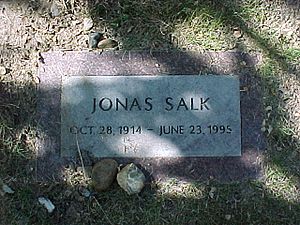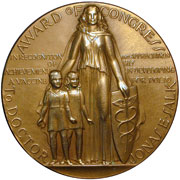Jonas Salk facts for kids
Quick facts for kids
Jonas Salk
|
|
|---|---|

Jonas Salk at Copenhagen Airport (May 1959)
|
|
| Born |
Jonas Edward Salk
October 28, 1914 |
| Died | June 23, 1995 (aged 80) La Jolla, California, U.S.
|
| Resting place | El Camino Memorial Park San Diego, California |
| Alma mater | City College of New York New York University University of Michigan |
| Known for | First polio vaccine |
| Spouse(s) |
Donna Lindsay
(m. 1939; div. 1968) |
| Awards | Lasker Award (1956) |
| Scientific career | |
| Fields | Medical research, virology, and epidemiology |
| Institutions | University of Pittsburgh Salk Institute University of Michigan |
| Doctoral advisor | Thomas Francis, Jr. |
| Signature | |
 |
|
Jonas Edward Salk (October 28, 1914 – June 23, 1995) was an American doctor and scientist. He is famous for creating one of the first successful polio vaccines. His work changed public health around the world and saved many lives, especially children, from the terrible disease of polio.
Contents
Early Life and School
Jonas Salk was born in New York City. His parents were Daniel and Dora Salk. He had two younger brothers, Herman and Lee. Lee later became a child psychologist.
When Jonas was a kid, he wasn't really interested in science or medicine. He once said that he was more interested in "things human." He wanted to understand people and how they lived.
At 13, Salk went to Townsend Harris High School, a special public school for very smart students. He then earned a degree in chemistry from City College of New York in 1934. After that, he went to New York University School of Medicine. While studying, he worked in a lab and as a camp counselor.
Early Lab Work
In 1941, Jonas Salk started working in a lab with a scientist named Thomas Francis, Jr. at the University of Michigan. Francis had discovered a type of influenza virus. This was Salk's first real look into the world of virology, which is the study of viruses. He found it very interesting.
After medical school, Salk continued to work with Francis. They worked on a project for the army to create a vaccine for the flu. Salk and Francis successfully made a flu vaccine that was used widely. Salk even found and isolated one of the flu strains that went into the final vaccine.
Polio Vaccine
Before 1955, polio was a very scary disease. It caused yearly epidemics, especially in the United States. In 1952, there was a terrible outbreak. Nearly 58,000 people got sick, and over 3,000 died. More than 21,000 were left with paralysis, meaning they couldn't move parts of their bodies. Most of the victims were children.
People were terrified of polio, like it was a plague. Every summer, families in cities worried about the disease returning. Many scientists worked hard to find a way to stop it. In 1938, U.S. President Franklin D. Roosevelt, who himself had polio, started an organization called the National Foundation for Infantile Paralysis. This group, now known as the March of Dimes, helped fund the search for a vaccine.
In 1947, Salk joined the University of Pittsburgh School of Medicine. The National Foundation for Infantile Paralysis asked him to study the different types of polio virus. Salk saw this as a chance to create a vaccine. For the next seven years, he and his team worked tirelessly on this goal.
To test Salk's vaccine, a huge study was organized. It involved 20,000 doctors, 64,000 school staff, and 220,000 volunteers. More than 1.8 million schoolchildren took part in the trial. On April 12, 1955, the news came out: the vaccine worked! Jonas Salk was seen as a "miracle worker." The day was almost like a national holiday. Countries all over the world quickly started using Salk's vaccine to protect their people.
Salk believed that public health was a "moral commitment." He wanted to create a safe and effective vaccine as fast as possible. He was not interested in making money from his discovery. In his later years, Salk also worked to find a vaccine against HIV.
Establishing the Salk Institute

After his polio vaccine discovery, many people helped Salk build his dream. He wanted a research center where scientists could study biology from the smallest cells to how societies work. This place is called the Salk Institute for Biological Studies. It opened in 1963 in La Jolla, California. The famous architect Louis Kahn designed the building. Salk hoped the institute would help new scientists in their careers.
Personal Life
In 1939, Salk married Donna Lindsay. They had three sons: Peter, Darrell, and Jonathan. They divorced in 1968. In 1970, Salk married Françoise Gilot, a French painter.
Jonas Salk passed away from heart failure on June 23, 1995, at the age of 80. He was buried in San Diego, California.
Honors and Recognition
Jonas Salk received many awards and honors for his important work:
- In 1955, he received the Meritorious Service Medal from Pennsylvania.
- Also in 1955, the City University of New York started a scholarship fund in his name for excellent pre-med students.
- In 1956, he was given the Lasker Award.
- In 1957, the building where he did his polio research at the University of Pittsburgh was renamed Jonas Salk Hall.
- In 1958, he was elected to the Polio Hall of Fame in Georgia.
- In 1975, he received the Jawaharlal Nehru Award and the Congressional Gold Medal.
- In 1976, he was named the Humanist of the Year.
- In 1977, President Jimmy Carter gave him the Presidential Medal of Freedom.
- In 1996, the March of Dimes Foundation created an annual $250,000 "Prize" for outstanding biologists to honor Salk.
- In 2006, the United States Postal Service issued a postage stamp in his honor.
- In 2007, he was inducted into the California Hall of Fame.
- Many schools in different states are named after him.
- Since 2012, October 24, Salk's birthday, has been celebrated as "World Polio Day."
- In 2014, on the 100th anniversary of his birth, Google Doodle created a special image to honor him.
Images for kids
-
With David Ben-Gurion in Jerusalem, 1959
-
Salk's bronze bust in the Polio Hall of Fame
See also
 In Spanish: Jonas Salk para niños
In Spanish: Jonas Salk para niños













